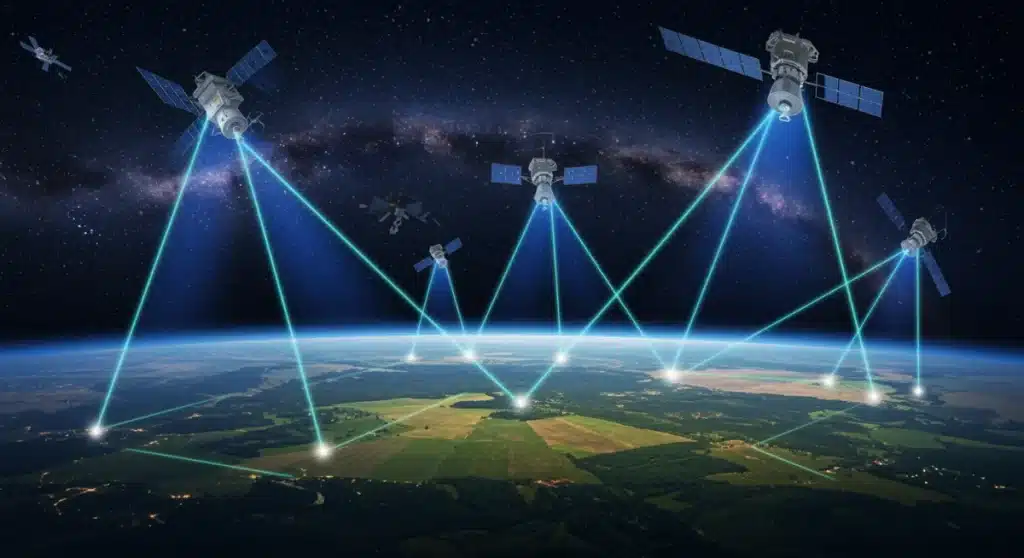Space-Based Internet: 10Gbps to Remote US by 2029

Satellite constellations are rapidly advancing to provide 10Gbps internet speeds to underserved remote US areas by 2029, a critical step in closing the digital divide and ensuring universal high-speed connectivity.
The promise of ubiquitous high-speed internet is closer than ever, with Space-Based Internet: How Satellite Constellations Will Deliver 10Gbps to Remote US Areas by 2029 emerging as a transformative solution. As of today, major players are accelerating deployment, aiming to bridge the digital divide for millions.
The Dawn of Ultra-High-Speed Satellite Internet
The landscape of internet connectivity is undergoing a monumental shift, propelled by advancements in satellite technology. For years, remote and rural areas across the United States have struggled with inadequate or non-existent broadband access. This digital disparity has limited economic opportunity, educational access, and critical communication. Recent developments indicate that this will soon change dramatically, with satellite constellations poised to deliver unprecedented speeds.
This new era of space-based internet 10Gbps connectivity is not merely an incremental upgrade; it represents a fundamental re-imagining of how internet services are delivered. Traditional terrestrial infrastructure, such as fiber optics and cable, faces immense logistical and financial hurdles when attempting to reach sparsely populated regions. Satellites, by their very nature, bypass these physical constraints, offering a viable and scalable alternative. Companies are investing billions into launching thousands of satellites into low Earth orbit (LEO), creating a mesh network that blankets the globe.
Key Technological Leaps Driving 10Gbps
Achieving 10Gbps speeds from space requires significant technological innovation across multiple fronts. These advancements are not just about more powerful satellites, but also about a complete ecosystem designed for high-throughput and low-latency communication.
- Laser Inter-Satellite Links: These links enable satellites to communicate with each other at light speed, reducing reliance on ground stations and significantly lowering latency.
- Advanced Phased Array Antennas: User terminals are becoming more sophisticated, capable of tracking multiple satellites simultaneously and optimizing signal reception.
- Onboard Processing: Next-generation satellites are equipped with advanced processors, allowing for more complex routing and data management in space, further reducing ground infrastructure needs.
- Increased Satellite Throughput: Each new generation of satellite boasts higher data capacity, thanks to improved transponder technology and more efficient spectrum utilization.
Projected Deployment and Market Leaders
The race to deploy these advanced satellite constellations is intense, with several key players driving the innovation. While the 2029 target for 10Gbps in remote US areas is ambitious, the current pace of launches and technological breakthroughs suggests it is increasingly attainable. The focus is not just on launching satellites, but on building a robust, resilient network that can support such high data rates.
Market leaders are not only competing for market share but also collaborating in certain areas, particularly in lobbying for spectrum allocation and regulatory frameworks. The sheer scale of these projects demands significant capital expenditure and a long-term vision. Governments, including the U.S. federal government, are also recognizing the strategic importance of universal broadband, often providing subsidies and incentives for companies to serve hard-to-reach areas.
Major Players and Their Strategies
Several companies are at the forefront of this space-based internet revolution, each with unique approaches to achieving global coverage and high-speed delivery.
- Starlink (SpaceX): Already a dominant force, Starlink continues to expand its constellation and enhance its technology, aiming for even higher speeds and lower latency. Their rapid deployment schedule has set a benchmark for the industry.
- Project Kuiper (Amazon): Amazon’s ambitious Project Kuiper is rapidly developing its own LEO constellation, promising to offer competitive services. Their deep pockets and expertise in cloud infrastructure could give them a significant edge.
- OneWeb: Focusing initially on enterprise, government, and aviation markets, OneWeb is also building a substantial LEO constellation with high-speed capabilities, often partnering with existing telecom providers.
Bridging the Digital Divide: Impact on Remote US Areas
The impact of space-based internet 10Gbps on remote US areas cannot be overstated. For too long, residents in these regions have been left behind in the digital economy, facing significant disadvantages in education, healthcare, and economic development. High-speed, reliable internet is no longer a luxury but a fundamental necessity in modern society.
With 10Gbps speeds, remote communities will gain access to opportunities previously unimaginable. Telemedicine will become more effective, allowing specialists to reach patients regardless of geographical barriers. Online education will offer world-class learning experiences to students in isolated towns. Furthermore, local businesses can expand their reach, participate in global markets, and foster innovation, reducing the economic disparity between urban and rural settings.
Transformative Benefits for Rural Communities
The introduction of ultra-fast satellite internet will catalyze a range of positive changes, reshaping daily life and economic prospects for millions.
- Enhanced Education: Students will have seamless access to online courses, research materials, and collaborative learning platforms, leveling the playing field with their urban counterparts.
- Improved Healthcare: High-bandwidth connections enable remote diagnostics, virtual consultations, and access to specialized medical expertise, improving health outcomes in underserved areas.
- Economic Growth: Remote work becomes truly viable, attracting new residents and businesses. Agricultural operations can leverage IoT and precision farming techniques for increased efficiency.
- Public Safety and Emergency Response: Reliable communication infrastructure is crucial during emergencies, facilitating faster response times and better coordination in remote locations.
Technical Challenges and Solutions for 10Gbps Delivery
Delivering 10Gbps speeds from space is an incredibly complex engineering feat, fraught with technical challenges. Overcoming these hurdles requires continuous innovation in satellite design, ground infrastructure, and network management. Latency, signal degradation, and capacity management are paramount concerns that engineers are actively addressing.
One of the primary challenges has been ensuring low latency, which is crucial for applications like video conferencing, online gaming, and real-time data transfers. LEO satellites, orbiting much closer to Earth than traditional geostationary satellites, inherently offer lower latency. However, maintaining consistent low latency across a dynamic network of thousands of moving satellites requires sophisticated routing algorithms and seamless handovers between satellites.
Innovations Overcoming Obstacles
The path to 10Gbps is paved with ingenious solutions designed to push the boundaries of satellite communication.
- Dynamic Beam Steering: Satellites use steerable beams to focus bandwidth where it’s needed most, adapting to changing demand patterns across different geographic areas.
- Advanced Modulation Techniques: Sophisticated encoding and modulation schemes maximize the amount of data transmitted per hertz of spectrum, increasing overall capacity.
- Global Ground Station Network: An extensive network of ground stations ensures robust connectivity between the satellite constellation and the terrestrial internet backbone, providing redundancy and high-capacity links.

Regulatory Landscape and Government Initiatives
The deployment of space-based internet 10Gbps infrastructure also navigates a complex regulatory environment. Governments play a crucial role in allocating spectrum, setting operational standards, and ensuring fair competition. In the United States, initiatives like the FCC’s Rural Digital Opportunity Fund (RDOF) are designed to incentivize broadband deployment in underserved areas, with satellite providers often being significant recipients of these funds.
Regulatory bodies are working to balance the need for rapid deployment with concerns about space debris, orbital slot congestion, and potential interference with other satellite systems. International cooperation is also vital, as satellite constellations transcend national borders, requiring harmonized regulations and spectrum management across different countries. The goal is to create a predictable and supportive environment for innovation while safeguarding the long-term sustainability of space.
Key Regulatory Considerations
Navigating the regulatory maze is as critical as the technological advancements for successful deployment.
- Spectrum Allocation: Ensuring sufficient and clear spectrum for satellite broadband to operate without interference is a continuous challenge.
- Orbital Debris Mitigation: Regulations are evolving to address the growing concern of space debris, requiring operators to plan for deorbiting satellites at the end of their operational life.
- Universal Service Obligations: Governments may impose obligations on satellite providers to serve specific unserved or underserved populations, often backed by subsidies.
The Future Beyond 2029: Sustaining and Evolving Connectivity
While 2029 marks a significant milestone for 10Gbps space-based internet in remote US areas, the evolution of satellite connectivity will not stop there. The industry is already looking towards the next generation of advancements, envisioning even higher speeds, greater capacity, and more sophisticated services. The long-term vision involves a truly global, seamless internet experience, where location no longer dictates the quality of connectivity.
Future developments will likely include more advanced satellite designs, potentially incorporating new propulsion systems for longer operational lifetimes and greater agility. Artificial intelligence and machine learning will play an increasing role in network management, optimizing data flow, predicting demand, and proactively addressing potential issues. The integration of satellite networks with emerging technologies like 5G and 6G terrestrial networks will also be a key area of focus, creating a hybrid connectivity ecosystem.
Next-Generation Innovations to Watch
The horizon of satellite internet is filled with promising developments that will shape connectivity for decades to come.
- Quantum Communication: Research into quantum key distribution via satellite could enable ultra-secure communication channels.
- Direct-to-Cell Connectivity: Future satellites may offer direct connectivity to standard smartphones, eliminating the need for specialized user terminals.
- Reusable Satellite Technology: Similar to reusable rockets, the concept of reusable satellites could drastically reduce launch costs and environmental impact.
- In-Orbit Servicing and Assembly: Developing capabilities to service, upgrade, and even assemble satellites in space could extend their lifespan and enhance their functionality.
| Key Point | Brief Description |
|---|---|
| 10Gbps Target by 2029 | Satellite constellations aim to deliver ultra-high-speed internet to remote US areas within the next five years. |
| Technological Advancements | Laser links, advanced antennas, and onboard processing are critical to achieving these speeds and low latency. |
| Bridging Digital Divide | Universal high-speed internet will transform education, healthcare, and economic opportunities in rural communities. |
| Key Industry Players | Starlink, Project Kuiper, and OneWeb are leading the charge in deploying and expanding satellite internet services. |
Frequently Asked Questions About Space-Based Internet
Space-based internet utilizes constellations of satellites, primarily in low Earth orbit (LEO), to transmit internet signals directly to user terminals on Earth. This technology aims to provide high-speed, low-latency broadband access, especially to areas underserved by traditional terrestrial infrastructure.
Achieving 10Gbps involves several innovations: advanced laser inter-satellite links for faster data transfer between satellites, sophisticated phased array antennas for efficient signal reception, and greater processing power on board the satellites to manage high data volumes effectively.
Major players include SpaceX’s Starlink, Amazon’s Project Kuiper, and OneWeb. These companies are investing heavily in launching thousands of satellites and developing the necessary ground infrastructure to support ultra-high-speed internet services globally, with a focus on remote areas.
The impact will be transformative. Remote US areas will gain access to reliable, high-speed internet, fostering economic growth, improving educational opportunities through online learning, and enhancing healthcare services via telemedicine, significantly narrowing the existing digital divide.
Yes, challenges include managing space debris, ensuring spectrum availability, and developing robust regulatory frameworks. Technical hurdles like maintaining consistent low latency and optimizing signal quality across a dynamic satellite network are also continually being addressed through ongoing innovation.
Looking Ahead
The rapid evolution of space-based internet 10Gbps connectivity represents a critical juncture for universal broadband access. As satellite constellations continue to expand and technology refines, the focus will shift towards sustaining these networks and integrating them seamlessly into a broader digital ecosystem. Watch for further announcements on satellite launches, advancements in user terminal technology, and evolving regulatory frameworks that will shape the future of connectivity, especially in previously underserved regions. The implications extend far beyond simple internet access, promising to reshape how remote communities interact with the global economy and access essential services.





